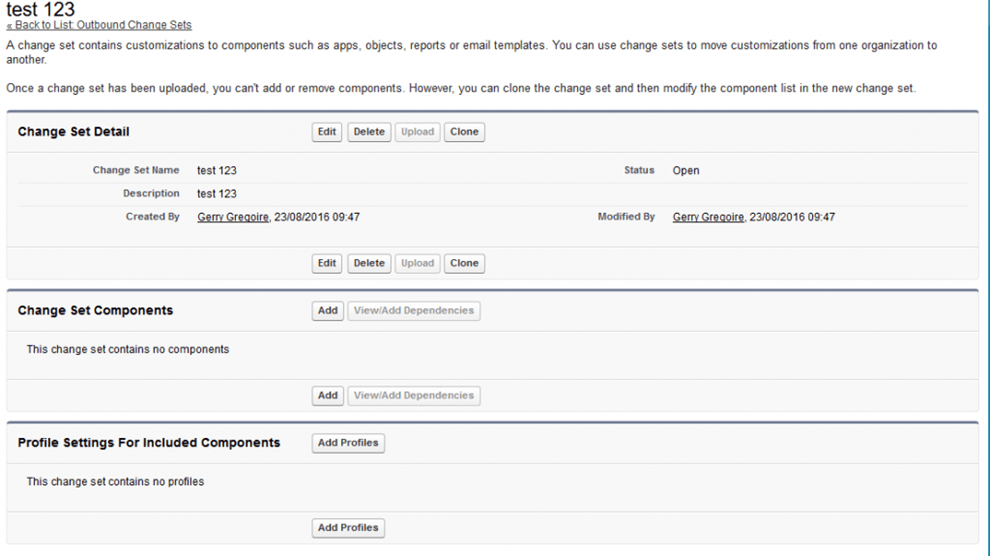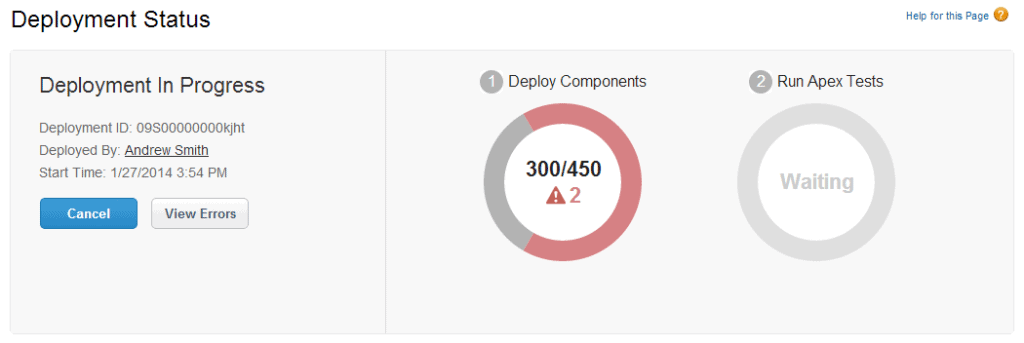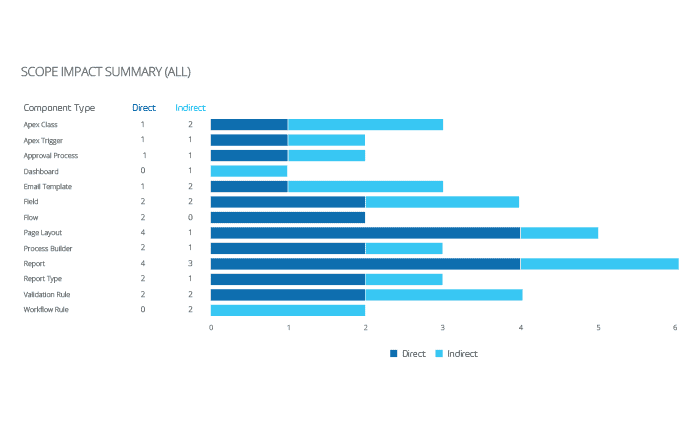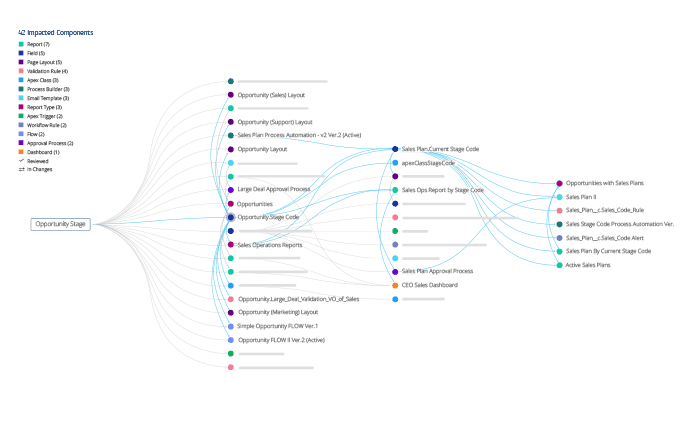Give Sandbox Authorization to Upload Changesets to Prod
As a software best practice, it's customary to do all development on a dev org, push button these changes to a exam org, and and so move all these customizations to an actual live/production org once testing is washed. The process of moving changes is chosen deployment, and Salesforce Change Sets are i of the just deployment tools in Salesforce natively for the migration and Salesforce deployment process of these changes.
Salesforce Change Sets, as part of the Salesforce deployment strategy, notwithstanding, are famously despised past Salesforce developers for their clunkiness, and oft do not comply with the deployment best practices of modernistic software development or even Salesforce deployment best practices.
The Changes Sets Salesforce provides exercise not offer robust risk analysis, they lack visibility into the effects of changes being rolled out for release, they provide no insights into the business impact and associated vulnerabilities, and they have no concrete way to catalog your changes without heavy manual direction.
But don't despair! Your Salesforce development projection doesn't have to rely entirely on the peculiarities of native Salesforce Change Sets. Beneath, we volition explore what Change Sets are and how to deploy using Change Sets in Salesforce, their mutual shortcomings, their pros and cons, and culling options to improve your change direction.

Panaya Tech Talk on Salesforce Org Health
What's a Healthy Salesforce Org and How Do I Get I?
WATCH Now >
What Are Salesforce Alter Sets?
In their simplest terms, Salesforce Modify Sets are the machinery by which changes from one Salesforce environment can exist pushed into some other Salesforce surround. Salesforce change set best practices ways you'll need to move changes out of an surroundings. You must get-go create an Outbound Modify Set and point it towards a receiving surround.

Your Change Prepare consists of components, and you will take to manually add every single component you created into your change set. A component tin can be various components of Salesforce development similar Apex Classes, Visualforce Pages, Fields, Lightning Components, Profiles, and other metadata.

Calculation components to a Change Set is unquestionably the most onerous part of Change Set direction using the Salesforce deployment tool, every bit it'southward very easy to forget components, even though Salesforce does listing some component dependencies in the Alter Set interface.
How do I Deploy a Salesforce Modify Set up?
So, how to create a change prepare in Salesforce? You volition have to upload your Outbound Change Prepare for information technology to become an Inbound Change Set, and get to your destination org to accept your Change Set and deploy it:

This Outbound Change Fix then becomes an Inbound Change Set to the destination org. The Inbound Change Set must be deployed in the destination org, and the changes must exist validated and laissez passer Apex test coverage (if relevant) before they can get live.

If yous encounter whatsoever error during the deployment (and you lot almost certainly will), errors are thrown and you must discern where your Change Set went wrong and diagnose how to set your initial Outbound Change Fix…and and then reinitiate the Outbound Change Fix to Inbound Change Set process. If your destination org accepts your Inbound Modify Set, and you've reviewed, validated and deployed, your changes are now alive.
Salesforce Change Set up Limitations
At present that yous're familiar with the basic concepts of creating and deploying Alter Sets, it is important to be aware of common ChangeSet Salesforce bug.
ane. Not Everything Tin Be Deployed
Change Sets do not back up all Salesforce components. An administrator will, therefore, have to perform some changes manually. Some examples of components not supported include standard picklist values, sales processes, divisions, organization-wide e-mail addresses, etc. Because of this limitation, an organization can face issues of:
- Increased deployment time
- Manual intervention
- The possibility of human being error
You might too want to check out our blog post: 5 Challenges when Deploying New SFDC Changes
two. Delivery Bondage Tin can't Be Maintained
Let's say you deploy a change set from dev to QA. All of your QAs verify your pattern is working properly, and it is set up to be moved to the production environment.
But you tin can't move the same change set to prod. Y'all will take to clone the change prepare, add together the dependent components and so reupload information technology. Particularly in organizations with multiple test environments, pre-prod, and and then prod, you lot can't found a chain when using change sets.
3. Only Connected Orgs Are Supported
Here, allow'southward say you create your dev and QA sandboxes from a unmarried production instance. All of these are connected orgs, and now you can use change sets to motility changes from dev to QA to prod. If the same product/app is used in multiple organizations, each having its own production instance, y'all cannot brand a connection from prod to prod.
This is a mutual scenario in healthcare where multiple hospitals use the same underlying Salesforce product just different production orgs.
With this trouble comes:
- Increased deployment time
- Lack of feasibility and reusability
- Redundant work
iv. Adding and Removing Elements Is a Drag
It's not piece of cake to create large change sets. You have to scroll through several pages if you have thousands of components, and y'all can't add together dissimilar types of components simultaneously.
To make matters worse, if you mistakenly add together some components and then demand to remove them, yous must do it one by one. Equally an alternative, many admins resort to browser extensions to resolve this issue, which speeds things up. The problem with this, nevertheless, is that these extensions take control of your data/lawmaking, which might be a alienation of your organization's compliance.
Drawbacks hither include:
- Very tedious to create/edit (frustrating)
- Possible compliance breach if browser extensions are used
5. No Chance Analysis Before Deployment
Modify sets lack any risk analysis of changes beingness deployed. This means you are unable to communicate risks to your stop-users beforehand, consequently decreasing reliability and increasing vulnerability of the deployment.
Many customers now must resort to gamble-identification apps to handle potential risks associated with deployments.Panaya ForeSight for Salesforce is one such tool that can requite you lot a risk assay view of the impact of your impending deployments.
So, not having proper risk assay leaves you with:
- Vulnerabilities and risks during deployment
- No dependency assay
vi. Not Integrated with Version Command Systems
Change sets cannot exist created automatically based on revision numbers from Git/SVN. A majority of organizations use Git/SVN to serve as their source of truth when multiple developers are coding in the aforementioned arrangement.
However, since modify sets are not integrated with source control, it takes extra endeavour to identify what changes were done and how to push each to change set manually one past one.
If multiple dev sandboxes are used, a developer might overwrite changes of another developer, as the source of truth for modify sets is Salesforce org, not Git/SVN. A solution is to use Jenkins or other cloud-based solutions to practise the deployment using Git/SVN as the source of truth.
Problems that ascend hither are:
- Fault-prone deployments
- The actress effort required to build change sets
7. Rollbacks Are Not Supported
Once you deploy a modify set to a destination org, you lot cannot undo the changes if needed. This means that your cease-users are stuck until you lot tin reverse all the changes in your QA org, recreate a alter set up, and so revert the change manually in prod.
Deployment failures and downtime can easily lead to loss of business concern if deployed changes are blocking their core activities.
Just one major outcome here: At that place'due south no fallback arroyo if things go incorrect.
8. Component changes are hard to track down to a specific change set
Unfortunately, modify sets are non integrated with leading project management software such as JIRA, Mantis, and Bugzilla, and you tin't create component groups within a modify set, since all components of all changes come up as a single listing.
This means you never get visibility into which components were modified per request, which is hazardous during backtracking to identify the root cause of an upshot.
Software such as Panaya ForeSight for Salesforce offers an easy-to-use UI to exist able to scope requirements, associate the components to these requirements, and analyze risks. This allows yous to understand, before the deployment procedure in Salesforce, the full telescopic of your projection and the exact areas of touch so you tin can efficiently plan your project.
The principal issue here: Lack of visibility into changes.
9. Not Congenital On Modern-Mean solar day SDLC Concepts
The SDLC concepts of CICD, risk mitigation, and commitment certainty are a ways away. Modify Sets are not compatible with continuous integration/continuous delivery. And it certainly doesn't consider the business impact that changes might pb to in production. Since there are no 1-click deployments, and we cannot constitute a delivery chain, deployments are uncertain. These are all different from present-day software evolution best practices.
Then here yous face problems of:
- Incertitude in deployments.
- Incompatibility with best practices.
The Pros and Cons of Modify Sets
Despite so many drawbacks, admins and developers are yet induced to use Alter Sets.
How accept Change Sets remained such a prominent tool for a Salesforce deployment for over 15 years? Here'south a quick summary of the pros and cons:
Pros
- No boosted price
- Declarative deployments tin exist managed with clicks
- Arable Supporting Documentation
Cons
- Adding components is cumbersome, fourth dimension-consuming and confusing
- High adventure of deployment failure
- Some features aren't even supported with Modify Sets
- Does not fully follow CI/CD all-time practices
- No roll-back functionality
- Limited risk analysis adequacy
- Just Connected Orgs are Supported
- Difficult to make up one's mind which Modify Fix an enhancement came from
- No connectedness between enhancement planning and Modify Sets
- Overall Deployment is insanely Time Consuming and Easy To Interruption
Alternative Options
What are the dissimilar ways of deployment in Salesforce? If you've ever managed a Salesforce deployment, you have probable experienced firsthand some of the inefficiencies of native Change Sets. And yous might have even encountered issues in your deployment process in Salesforce and releases non listed here. So how can you reach a more than modernistic and secure release management?
You could create your own version control and bear upon analysis systems yourself, or you tin leverage the work of pros who have gone before you lot.
Source Control, Jenkins:
Showtime off, you can use a source control system such as Git/SVN to manage your source of truth. This eliminates the limitations of code-merging and promotes better code-tracking. You should also implement Salesforce deployment tools to deploy components from these source control systems.
Jenkins is one such Coffee program that contains packages for Salesforce integration. You can configure information technology locally or use a cloud-based solution.
Change Intelligence with Impact Analysis, Panaya ForeSight:
Secondly, you lot need to explore risk assessments and touch on analysis.
Tools such as Panaya ForeSight for Salesforce have used technology to drive and calculate the dependencies of change with hazard identification so you can deploy with conviction.
Panaya ForeSight is one of the best Salesforce change management tools to allow developers, admins and architects to program their Salesforce changes while keeping potential impacts on the existing system in mind. Past running a Take a chance Assay for a proposed modify earlier a requirement is fifty-fifty fulfilled, developers tin have a clear understanding of areas of potential breakage, long before their code needs to be pushed into a higher environment.

Panaya ForeSight also offers deep insight and touch on chance into every scoped component, allowing for easier management and consignment of all evolution and release-related tasks. The affect graph provides a articulate visualization of the dependencies inside the Salesforce Org and how they relate to a planned change.

ForeSight allows test cases to be associated with individual changes and so that you can appraise whether high-impact stories take been tested rigorously. And this ways yous—and your bosses—tin can sleep meliorate.
Go on Calm and Change Set On
Salesforce Change Sets tin be painful to utilize, only a successful deployment doesn't accept to fail because of their shortcomings.
Past learning about the mutual bug associated with Salesforce Change Sets and by careful pre-planning, y'all can prepare yourself for a successful Salesforce deployment strategy. Leverage existing technologies like Panaya ForeSight before you plan your deployment to make your Change Set management process a success from the kickoff.
Source: https://www.panaya.com/blog/salesforce/salesforce-change-sets/
0 Response to "Give Sandbox Authorization to Upload Changesets to Prod"
Post a Comment